Guide to building an effective employee experience strategy
Here's how the physical environment, culture and technology shape the employee experience -- and the steps you can take to improve it. It starts with listening.
The employee experience has been a main focus of the HR discipline and the driving force behind many organizations' HR strategies in recent years. It is also a design principle and marketing buzzword for HR technology vendors.
But what does employee experience really mean, and how can organizations implement an employee experience strategy when the concept seems so amorphous?
The challenges of formulating an effective employee experience strategy stem from the fundamental reality that employee experience has more to do with human nature and corporate culture than it does with the speed and predictability of technology.
To be sure, there are plenty of minefields related to employee experience technology. The risk of throwing money away on HR software that is overhyped as an employee experience "solution" is high. On the other hand, surgical deployment of inexpensive applications can be the very thing that brings about measurable improvements in the employee experience. The trick is knowing the difference between the two before committing resources to employee experience technology or taking other actions that make things worse instead.
What is employee experience?
Let's start with a basic definition. Employee experience refers to a worker's perceptions about their journey through all of the touchpoints of an organization, from their job candidate days to their exit from the organization and even beyond. The physical workspace, culture and technology are the three major components of employee experience, which is often abbreviated as EX. Some experts break down EX components into social, physical and work, but the idea is similar: Both descriptions are an attempt to categorize the elements that employees interact with and are known to have the biggest impact on how they feel about their jobs, their coworkers and their company.
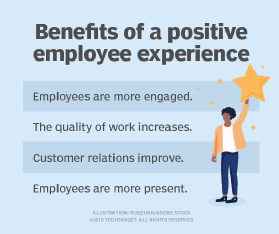
Think of it like a three-legged stool: You need all three legs to stand up an effective employee experience strategy.
Much of the key terminology for employee experience draws heavily from the customer experience, a concept that predates it. The customer experience is determined by a customer's "journey" through the buying process, especially "touchpoints" or "moments that matter," such as their first encounter with an e-commerce site or customer service representative, when they are faced with a decision that determines whether they stick with a product or brand.
As you'll see, having a detailed understanding of the key touchpoints in the employee lifecycle is essential to building an employee experience strategy.
Factors in the employee experience
Let's drill down into the three main components of the employee experience and see why they have such a big impact:
- Culture. In its broadest sense, this includes the corporate culture and how much it hurts or helps in creating a positive employee experience. A culture that is too hierarchical and autocratic, for example, is likely to put a damper on employees' ideas and career aspirations, while one that is extremely informal and disorganized may not inspire trust or long-term commitment. Culture also includes specific people issues, such as the availability of after-work social activities and how well a worker gets along with their boss or feels supported in their job.
- Physical workspace. This is everything in the work environment that meets employee needs or works against them, from comfortable ergonomic desks and chairs to healthy cafeteria foods and clean, temperature-controlled air. Office designs can also strongly determine how easy it is to collaborate and call ad hoc meetings or find privacy when needed. The recent trend toward open office designs reflects a deliberate attempt to improve not just the physical workspace, but the culture and technology sides of the employee experience.
- Technology. Technology is the catchall category for the tools employees use in their jobs. In an office setting these tools are almost entirely digital. Hard-to-use technology degrades the employee experience and reduces productivity, while user-friendly and up-to-date tools can give employees a feeling of empowerment.
Employee engagement is another important factor in any employee experience strategy. It refers to how a person feels and thinks about their job and employer, and the degree to which they feel committed to their work and to the organization. Employee engagement, for the most part, is an effect of the employee experience -- not a driver of it. That's why measuring employee engagement is the most common way to put numbers and science behind the slippery concept of employee experience. It's the best way to see how happy employees are with the culture, physical environment and technology, and also the basis for soliciting ideas for improvements and checking into whether the changes met expectations.
As a result, to be effective, an employee experience strategy has to include a serious, methodical way to measure employee experience and satisfaction. Typically, this is done through online employee surveys.
Eight quotes from business leaders to inspire your employee experience initiative.
How can it affect your business?
Research studies suggest that a positive employee experience leads to other positive effects, including the following:
- Higher productivity. More satisfied and engaged employees work harder and smarter, producing more and wasting less -- both of which directly benefit the bottom line.
- Improved employee retention. Happier employees are less likely to leave, which in turn builds up the skills and experience of the entire organization.
- Lower turnover. The flip side of improved retention, this result helps avoid the cost of recruiting and training replacement workers.
- Reduced absenteeism. This effect boosts productivity and morale.
- More creativity and innovation. Employee satisfaction is known to correlate with openness to new ideas.
- Better customer experience. Happy employees tend to express more positive impressions of their company, its products and services and also deliver a higher level of customer service.
Those benefits and avoided drawbacks ultimately boost revenue or reduce costs (or both), leading to higher profits. But avoiding the bad effects of a negative employee experience, such as high turnover that hurts productivity and raises talent acquisition costs, may be just as important.
The role of technology in the employee experience
Information technology plays a major role in an employee experience strategy because of its triple impact on the day-to-day experiences of employees. First, IT is usually the mechanism through which employees carry out their own HR transactions and interact with the HR department. Second, IT applications are the means by which many employees do most of their work. Third, technology is often the primary tool that HR, departmental managers and executives use expressly to analyze and manage the employee experience itself.
Besides the aforementioned engagement and collaboration tools, there are many applications that support the employee experience. The human resource management system (HRMS, aka HRIS) is the system that handles most of the HR transactions that employees need to make, such as changing their withholding tax or requesting tuition reimbursement. An HRMS that makes it hard to request or execute transactions or, worse, does them incorrectly is a major detractor from a positive employee experience. Service management tools such as HR help desks can make the process of requesting or executing changes go much more smoothly. An intranet can be the friendly, familiar entry point to an employee's entire roster of applications while serving as a communication channel for sharing news and other transmitters of company culture. Health and wellness apps and websites can boost employees' well-being and demonstrate that the organization cares about them.
There is a sizeable category of vendors that make employee engagement tools to measure or improve employee engagement -- and sometimes both. They include the surveys and other feedback mechanisms for gauging and fostering engagement, as well as collaboration and project management platforms that help people work more effectively as members of teams, which in turn can engender a greater sense of belonging.
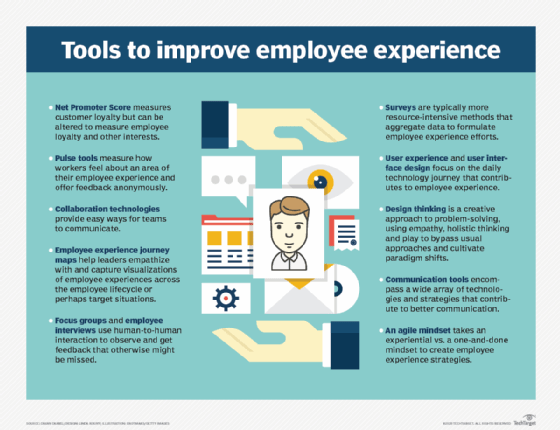
Some organizations are now trying to take a more holistic and integrated approach to improving the employee experience by further automating the HR processes that employees encounter most often in their journeys. They're doing so by adding HR chatbots, AI and HR-specific workflows -- all intended to automate employees' HR requests. Some are calling in systems integrators to tie together their disparate HR and ERP systems to create a de facto employee experience platform. Vendors of help desk and human capital management software are gradually assembling such platforms or providing comparable capabilities.
The experiences employees have while using their organization's IT infrastructure and software are sometimes called the digital employee experience and are increasingly considered part of the employee experience strategy. Ensuring positive experiences requires putting the needs of the employee front and center when planning technology purchases. One way to do so is for HR and IT to work in close partnership -- not just when it comes time to implement new HR technology.
Digital adoption platforms, which embed instructions right inside the applications employees use at work, can ease onboarding and make the experience of using office systems more productive and enjoyable.
The bottom line is that having a strategy for planning and implementing a complete digital workplace transformation can go a long way to improving the overall employee experience.
These seven statistics show how you can reshape your employee experience.
How to build an effective employee experience model in five steps
HR consultants, software vendors and systems integrators tend to recommend similar steps for an organized effort to address all three pillars of the employee experience.
A commonly used method is design thinking, an iterative approach that brings together workers with diverse backgrounds and experience to solve a practical problem together -- in this case, how to improve the employee experience. Participants first gather feedback from stakeholders to learn more about the problem, then agree on a definition of the problem, after which they brainstorm and prototype ideas before presenting the best candidates to the stakeholders.
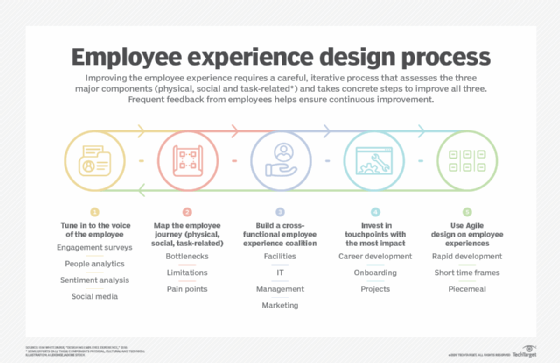
The IBM Institute for Business Value published a white paper, "Designing employee experience: How a unifying approach can enhance engagement and productivity," that neatly explained the major steps in implementing an employee experience strategy and the essential tactics and tools.
The infographic above shows the basic steps and checklist items. Here's more detail.
1. Tune in to the voice of the employee
Start by asking employees about their experience and how it could be made better. Consider sending out a regular employee engagement survey that repeats some of the same questions to show trends over time.
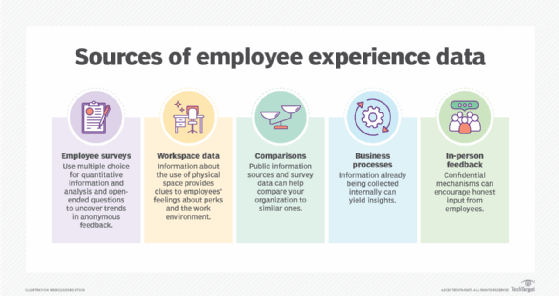
A more sophisticated tool is employee sentiment analysis, another approach borrowed from customer experience management. Sentiment analysis technology allows a much greater degree of automation than surveys. It uses natural language processing to analyze the employee feedback in unstructured data, such as social media and email, then characterizes and quantifies how employees feel about the organization.
Both approaches should be part of a broader strategy of using people analytics tools to better understand employees.
2. Map the employee journey
The best way to document an employee's journey through the company is to create an employee journey map, which requires identifying "personas" -- job types, such as IT or sales, entry-level or C-suite -- and the touchpoints they typically encounter. Then gather feedback from the employee about their experience at each touchpoint and note ideas for improvement.
Journey mapping is also an exercise in empathy that demands frequent check-ins and a willingness to take a holistic view of the employee, including life goals.
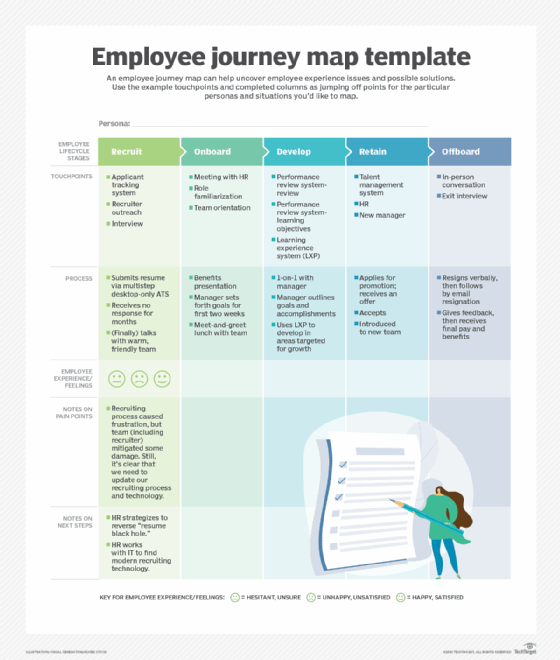
3. Build a cross-functional employee experience coalition
Design thinking calls for having all of the people who affect the employee experience sitting at the table. Besides HR, at a minimum you should have representatives from facilities management, IT, corporate management and marketing.
4. Invest in touchpoints with the most impact
The journey mapping process will tell you about the moments that matter most to particular employees -- that is, if you haven't already used empathy to figure much of it out. The employee onboarding process is almost always a big one, because it's the major step after recruitment when new employees get a better idea of the culture, physical workspace and technology of their employers. A difficult onboarding experience can set an employee on a bad path that leads to early departure and negative recommendations to prospective job candidates. Career development is another major touchpoint that can tilt the employee experience either way. Being assigned to meaningful projects that test skills and creativity can help employees feel engaged and can become another moment that matters in the employee journey.
5. Use agile design on employee experiences
Techniques borrowed from agile software development work well in an employee experience strategy and align closely with design thinking. Experts advise using rapid development methods to come up with solutions that can be implemented quickly and will address the problems identified in the earlier steps, even if they only do so for a short time. Don't try to fix the whole problem at once. Tackle small, manageable pieces.
Then start from the beginning and do it all over again. Improving the employee experience is a never-ending process that should pay off with happier employees, higher productivity, better ideas and a healthier bottom line.
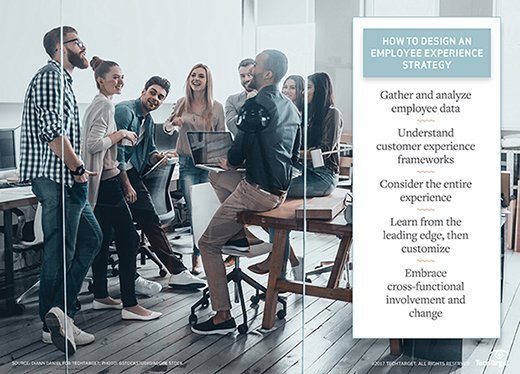
Future of employee experience
As HR professionals grapple with how to build a great employee experience strategy, they are also having to address the lingering effects of an event that redefined the nature of work almost overnight. The COVID-19 pandemic upended workplaces and made remote work the new normal. For millions of workers, the employee experience now happens at home. In response, HR has partnered with IT to ensure HR systems are available remotely 24/7 and worked with executives to adjust work policies ranging from sick pay to performance reviews to hiring. It is also charged with formulating hybrid work strategies that encourage workers to return to the office without damaging the overall employee experience.
Looking for more EX tips and tricks? Check out these eight employee experience experts to follow on social media.
How the future of employee experience strategies plays out at companies remains to be seen. But it is certain that many of the components and best practices of employee experience that worked pre-pandemic will be different for a workplace where more employees will be permanently remote and many companies will offer a mix of remote and in-office work options.
Meanwhile, more companies are getting serious about integrating their customer and employee experience efforts in a "total experience" strategy. The pandemic spurred customer and employee demand for more personalized and streamlined digital interactions, and organizations are looking to serve those needs while taking better advantage of potential synergies that arise from linking the two realms. But, so far, there isn't a single total experience platform, and companies must continue with a piecemeal approach to improving the employee experience.







